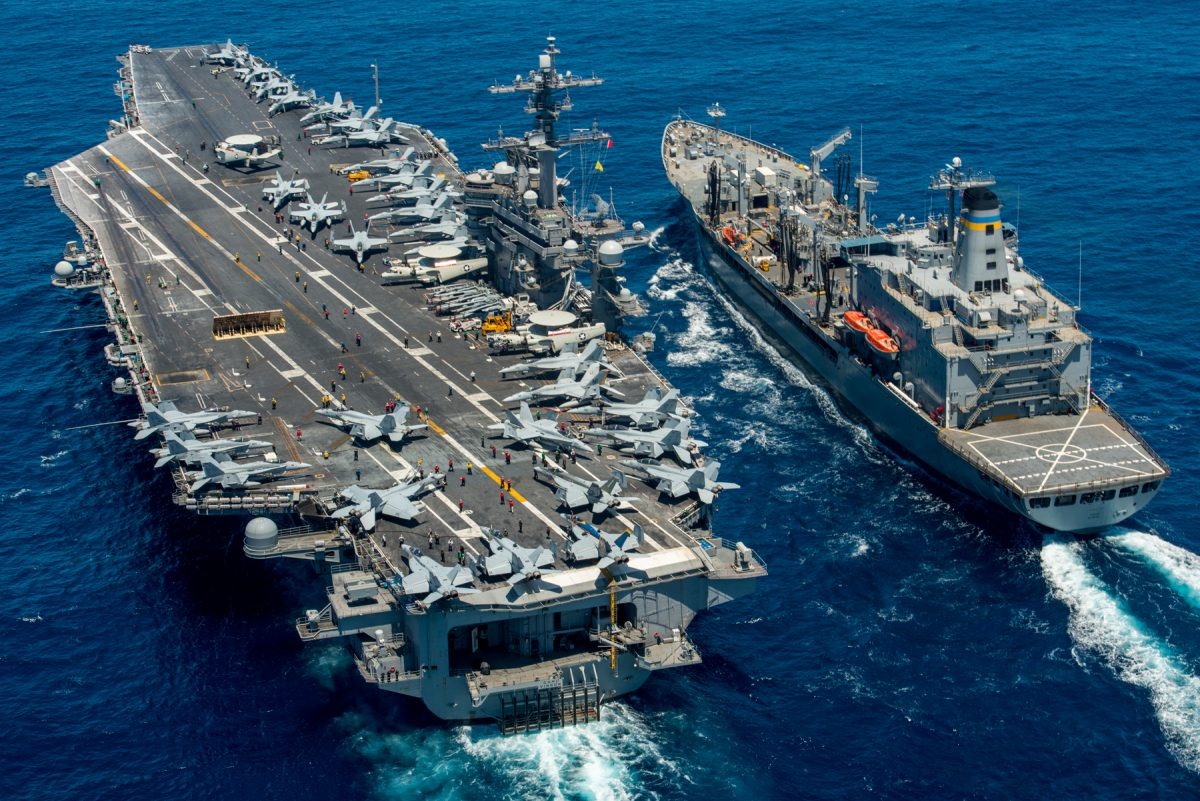Dass der Iran „erledigt“ werden soll, durch die USA, ist zwischenzeitlich allen klar.
Der Angriff gegen den Iran kann eigentlich nur von Flugzeugträgern erfolgen.
Die USA haben zwar in der Region (z. B. in Katar) Flugbasen, ABER, es ist unwahrscheinlich, dass arabische Staaten den USA erlauben, Kampf- Einsätze gegen den Iran, von ihrem Territorium aus zu fliegen.
Y
Die USA müssen sich also auf ihre fahrbaren Flugplätze= Flugzeugträger verlassen.
2 Flugzeugträger sind im Rahmen einer General-Überholung in der Werft (Stennis und Truman), einer ist vor der Ost- Küste der USA und macht dort Piloten- Training (Washington), und die Nimitz ist gerade aus Bremerton / Washington ausgelaufen, um die Reagan in Japan (die in die Iran- Kampf-Zone fährt), zu ersetzen.
| CVN 74 USS J.C. Stennis | <Shipyard> | CVN 75 USS H.S. Truman |
| US | CVN 73 USS G. Washington | |
| CVN 68 USS C. W. Nimitz | Japan | |
| +++++++++++++ | +++ | ++++++++++++ |
| From US-East-Coast to WarZone > | < From US-West-Coast to WarZone | |
| WarZone? | CVN 71 USS T. Roosevelt | |
| CVN 77 USS GHW Bush | WarZone? | CVN 72 USS A. Lincoln |
| CVN 69 USS D.D. Eisenhower | WarZone | CVN 70 USS C. Vinson |
| CVN 78 USS G. R. Ford | WarZone | CVN 76 USS R. Reagan |
Bis zu 7 Flugzeugträger können die USA vor dem Iran auffahren lassen.
Per Flugzeug-Träger kann man 40-50 Kampf- Flugzeuge rechnen (je nach Belegung der Träger / die anderen auf dem Träger befindlichen Luft-Fahrzeuge sind keine Kampf- sondern diverse Luft-Fahrzeuge, da gehören Hubschrauber dazu, Radar- Flugzeuge, etc.).
Wenn 4 Flugzeugträger den Iran angreifen, so sind das 160 bis 200 US- Kampf- Flugzeuge, bei 7 Flugzeugträgern kann man 280 bis 350 US- Kampf- Flugzeuge annehmen.
Da hat doch der Iran keine Chance – oder?
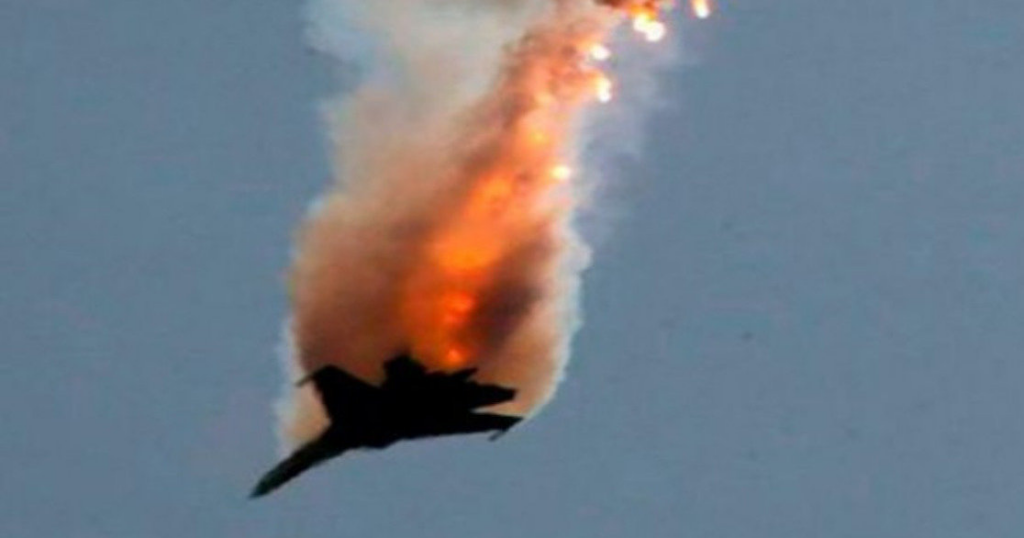
Iran mit S300-Joker
Das kommt darauf an – auf die Menge jener S300, die Russland an den Iran geliefert hat.
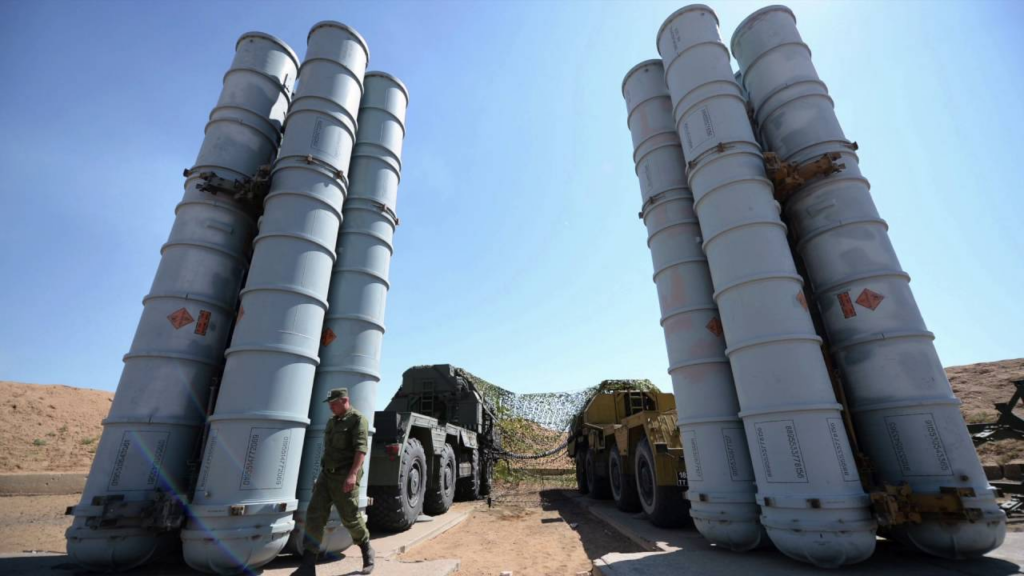
Bild oben: S300= jeweils 4 Rohre per Abschuss- Rampe (hier 2 Abschuss-Rampen zu sehen, die jeweils auf einem LKW montiert sind).
Russland hatte am Höhepunkt seines S300-Einsatzes ca. 1.900 S-300 Abschuss-Rampen, die jeweils aus 4 Rohren bestanden (die neue S400 besteht auch aus 4 Rohren).
Jedes dieser Rohre ist jeweils mit einer Rakete geladen. Wenn diese abgeschossen wird, ist das Rohr leer, und wird dann durch ein neues Rohr mit Rakete (vom Werk im Rohr montiert) ersetzt. Das alte Rohr geht in das Werk zurück, und wird dort mit einer neuen Rakete befüllt.
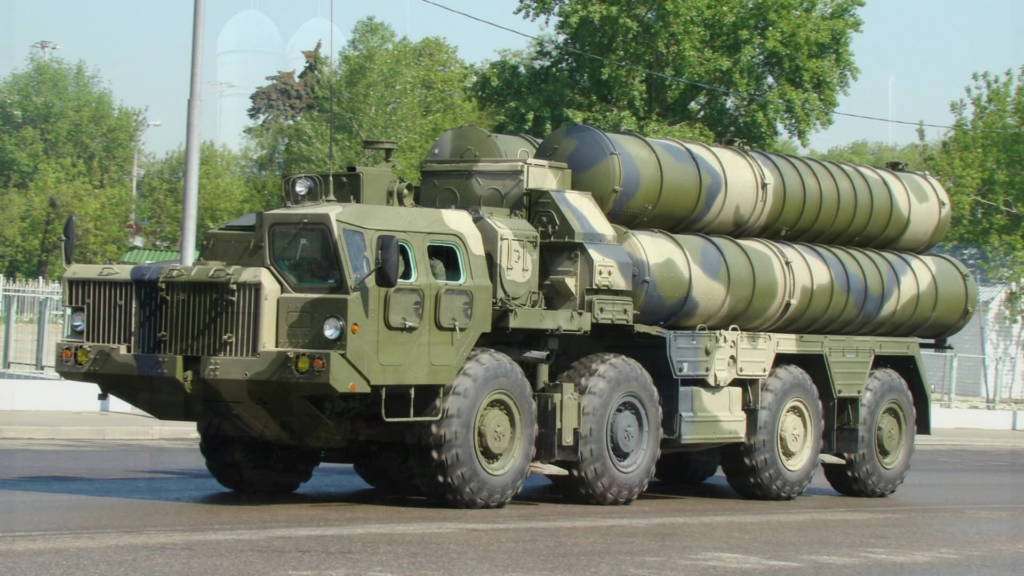
S300 Abschuß-Vorrichtung auf LKW montiert.
Wenn der Iran 100 dieser LKW- montierten Abschuss- Vorrichtungen gekauft hat, kann er mit einer Abwehr- Salve (ohne nachladen) 400 Raketen abfeuern. Nimmt man eine Trefferquote von 75 % (als eine niedrige, denn 90 % gelten als Standard), so würden 300 Raketen ihr Ziel treffen (OHNE nachladen, sobald nachgeladen wird, sind die nächten 400 Raketen einsatzbereit).
Wenn die USA 280-350 Kampf- Flugzeuge schicken (siehe obige Rechnung), und 300 S300-Raketen treffen, dann – nunja -sieht nicht gut aus, für die US- Navy.
Aber, die USA haben doch Stealth- Flugzeuge wie den F35, die sind doch unsichtbar – oder?
Sehen Sie hier Pierre Sprey, ab Ende der 1960er- Jahre im US- Verteidigungs- Ministerium aktiv (einer von McNamaras Whiz-Kids), und im Rahmen der “Fighter-Mafia” für die Entwicklung der F16 und der A10 zuständig.
Die F15 wurde von einem anderen Fighter-Mafia-Mitglied, Colonel Boyd (auch für seine OODA- LOOP- Theorie bekannt), zur Entwicklung und Serienreife gebracht.
Stealth- Fighter/Bomber wie F22, F35 und B2 unsichtbar für Radar – UNSINN – beachten Sie hier vor allem, ab Minute 06:15.
Jedes Langwellen-Radar aus 1942 kann die Stealth-Flugzeuge entdecken (und genau diese Lang-Wellen-Radar-Technik hat Russland immer weiter perfektioniert – u. a. bei Woronesh).
Fattah= US- Flugzeugträger in Gefahr?
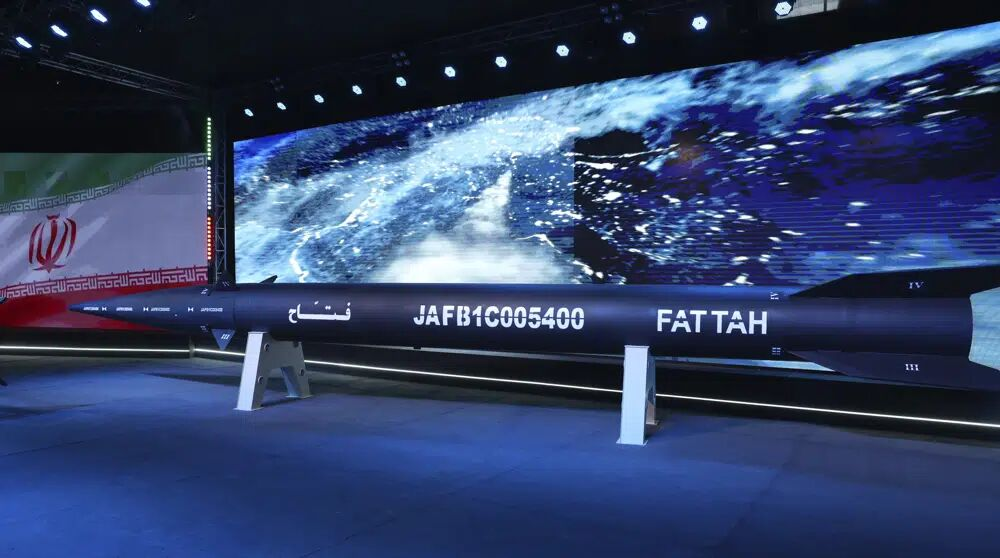
General Hajizadeh made the remarks on Thursday at a gathering of professors and students of the University of Mazandaran, in Mazadnaran province, in northern Iran.
Making a reference to Fattah, a domestically-produced hypersonic ballistic missile unveiled earlier this month by the IRGC Aerospace Force, General Hajizadeh said that the range of the Fattah hypersonic missile can be increased to 2,000 km from its current range of 1,400 km.
He said that the Islamic Republic of Iran has mastered all complicated technologies in the field of the defense industry, adding that it should be much easier for the country to solve problems in other fields such as manufacturing and agriculture as they are much simpler.
FPI-Anmerkung: Hypersonic mit einer Geschwindigkeit von 15 Mach.
+++ +++ +++
An Iranian defense analyst has appreciated the recent unveiling of the Abu Mahdi missile and gave more information about it through his interview with the Islamic Republic News Agency.
‘Abu Mahdi’ cruise missile was added to the naval fleets of Iran’s Islamic Revolution Guards Corps (IRGC) and Army on July 25, 2023. Also, just a few months ago, Iran unveiled its first long-range hypersonic missile, dubbed Fattah, as well as Khorramshahr 4.
Below is the full text of the IRNA interview with the defense analyst, Kiarash Jalili, to shed more light on Iran’s military capabilities.
Q: Abu Mahdi cruise missile was added to the naval fleets of Iran’s IRGC and Army on July 25, 2023. Why this missile has attracted so much attention and what capabilities could it give to the Iranian armed forces?
A: The Abu Mahdi is an anti-ship missile with land attack capability that flies at a subsonic speed of approximately 900 km/h and maintains a low altitude, making it difficult for enemy radar systems to track and intercept. Unlike ballistic missiles that follow a high arc trajectory, this missile flies like an airliner.
What sets this missile apart from its counterparts, such as the Russian Kh-55 or the American Tomahawk that use turbofan engines, is its use of a single Iranian-made turbojet engine from the Toloue family. This choice helps keep costs low, enabling increased production rates for the missile. Additionally, its pop-out wings feature makes storage and transportation more convenient.
Equipped with a multi-layered advanced guidance system, the Abu Mahdi cruise missile can fly accurately over both land and sea, a significant improvement compared to previous Iranian anti-ship cruise missiles like Ghadir, Ghader, and Noor, which had limitations when flying over land. Its extended range and AI-supported navigational systems enable it to bypass enemy air defense systems or loiter and strike a target from its most vulnerable position at the right time.
The missile’s extended range enables the Iranian armed forces to target enemy ships in the Strait of Hormuz all the way from the country’s capital, Tehran for instance. Previously, this capability was only achievable with a yet-to-be-named Iranian anti-ship ballistic missile which has a range of 2,000 km. Similarly, Iranian ships can now strike deep inland enemy targets, which significantly enhances their stand-off capabilities and survivability in a battlefield. The missile’s in-flight re-rerouting capability allows it to receive real-time updates on the target’s location, ensuring that any movements made by the target are taken into account and enabling the missile to adjust its trajectory accordingly.
It’s worth noting that the Abu Mahdi cruise missile belongs to the same family of Iranian cruise missiles that received praise from the former head of the Zionist regime’s Missile Defense Organization. He had famously said, „I take my hat off to the guys who did it technically,“ emphasizing the missile’s technical prowess.
According to current news, Iran is already working on the second generation of this missile, which will have double the range, reaching up to 2,000 km. This advancement will further extend the missile’s operational capabilities.
Q: Iran unveiled its first hypersonic missile (Fattah), what makes this missile so special and important?
A: Let’s talk about Fattah’s overall design first:
Fattah is a so-called two-stage missile, which means it has two engines stacked on each other, the first stage is jettisoned after its fuel is depleted to reduce the weight and maximize efficiency. Fattah uses solid fuel in both stages, using solid fuels in missiles generally reduces the preparation time before launch, so there is less time for the enemy to target launch sites, or to move its assets out of harm’s way, and it also increases the rate of fire for Iranian forces. Solid fuel is also safer when it comes to transporting missiles and stockpiling them. Liquid-fuel missiles can be stored for a few days, while solid-fuel missiles can be stockpiled for two to three decades with minimal maintenance.
Fattah has an official range of 1,400 km, the second-stage engine kicks off when the warhead is 400-300 km away from its target. The second engine not only helps the Fattah’s warhead to perform evasive maneuvers, but it also accelerates its speed.
B: What makes this missile special is due to several reasons:
Iranian engineers have successfully developed a more compact second engine for the Fattah missile, effectively integrating it into the warhead. This advancement brings several benefits, including easier transportation and storage of the missile. Furthermore, it significantly reduces the radar signature of the missile, resulting in delayed detection by enemy radar systems.
The second stage uses Thrust vectoring technology. It basically allows Fattah to change the direction of its engine thrust, making it more maneuverable both in the atmosphere and in outer space. Remember, in outer space, there is no air, so conventional methods of flight control, such as steering fins won’t work up there, so having this thrust vectoring technology is essential for Fattah to perform evasive maneuvers in midcourse and to dodge enemy exo-atmospheric anti-missile systems such as the Zionist regime’s Arrow 4 system, which is currently under development and funded by American taxpayers.
Thirdly, because it is manufactured by a government body, Iran’s Ministry of Defense, it is inexpensive, so Iranian can produce more of them, especially with the low defense budget that they have, and, target more hostile targets and saturate enemies’ missile shields. The low cost of this weapon allows Iran to maintain its firepower in a long-term conflict. Even if all Fattahs are intercepted by enemies’ anti-missile systems, Iranians can still produce more Fattahs, significantly faster and cheaper, than the US defense industry can manufacture anti-ballistic missiles. Unlike in the US, Iran is not run by corporations and lobby groups. There is no competition to make weapon systems fancier and more expensive by corporations at the expense of healthcare and educational systems. Very similar to Iran’s accomplished MAPNA group, the Iranian defense industry combines the strengths of both the private and public sectors to provide high-quality products while keeping costs low. Based on the latest reports, the Iranian Ministry of Defense is currently in contact with over 6,500 manufacturing companies, approximately 1,400 of which are technology startups run by young Iranian boys and girls.
In addition to the thrust vectoring technology that I mentioned earlier, the Fattah’s warhead is also equipped with fins to help it maneuver better in the final stage. The fins are relatively small and supported by ramps to protect them against high temperatures at high velocities. Small fins indicate that the Iranian engineers have prioritized higher speed and lower radar signature over a longer range.
Moreover, the warhead’s nose has been extended to reduce drag and radar signature, allowing it to go faster and not be detected easily.
We know very little about Fattah’s guidance system, but this is the actual masterpiece in my opinion, a crucial element when it comes to building a hypersonic missile. Performing evasive maneuvers at such high speeds puts enormous structural pressure on the warhead. Radio frequencies are disrupted at hypersonic speeds so it becomes very challenging to use conventional navigational methods such as radar or satellite to find the target. The guidance system must constantly change the direction of the warhead to evade the enemy and yet make it land on the target with pinpoint accuracy.
Hypersonic missiles like the Fattah typically follow a depressed trajectory, which means they fly at lower altitudes and for an extended duration during the midcourse phase compared to their predecessors. This approach enables them to remain hidden from enemy detection for a longer period. However, this trajectory exposes them to intense pressure, necessitating the use of advanced alloys in their construction. These sophisticated materials are essential for the missiles to withstand the tremendous heat and forces experienced during extended flight at such low altitudes and high speeds.
Q: What other countries have this technology? How long it took for these countries to achieve it? Is there any possibility this missile could be easily targeted by air defense systems like the Iron Dome?
A: Other countries that possess hypersonic weapons include China, Russia, and North Korea. There are other states that are also trying to catch up and develop this valuable technology, such as the American regime, Japan, India, and France. Due to the sensitivity of the topic, it is difficult to determine exactly how long each country has been working on this technology. However, hypersonic missiles are indeed a growing trend. The Chinese Dongfeng-17 entered service in 2019, the Russian Kh-47M2 Kinzhal was fielded in late 2017, and the North Korean Hwasong-8 was tested in 2021. While American arms manufacturers are still in the initial phase of milking the American taxpayers. They have faced challenges and delays. For instance, the plans to procure the Air-Launched Rapid Response Weapon (ARRW) were scrapped after multiple failures, and another system called the Long Range Hypersonic Weapon (LRHW) is yet to enter service.
Regarding the third part of your statement, I would like to clarify that it is already very challenging to intercept modern missiles using current anti-ballistic missile systems, let alone hypersonic missiles like Fattah. Stopping a hypersonic missile will continue to pose a significant challenge in the foreseeable future, although technological advancements are constantly being made. Similar to riding a bike, those who stop progressing will face setbacks. By the time the enemies manage a way to stop Fattah, it is a safe bet to assume that Iran will already have come up with a more sophisticated system.
The Iron Dome is an air defense system responsible for taking out short-range rockets and artillery shells and it will not be able to intercept Fattah or any other Iranian medium or short-range ballistic missiles. There are other systems that are marketed as being able to intercept Iranian missiles such as Patriot 3 and THAAD, but as we have witnessed with the successful targeting of Zionist regimes’ INS Hanit in 2006 when it was claimed the ship’s defense systems were turned off, the retaliatory attack on Aramco in 2019 where it was claimed that Patriot systems were facing south and the attack came from the north, or in the aftermath of Iran’s historic retaliatory attack on the American terrorists bases in Iraq as part of Operation Martyr Soleimani where in response to why they did not shoot down Iranian missiles, the Americans stated that they saw the missiles coming and took cover in time instead. Other instances happened when American terrorists occupying Syria came under attack and claimed their air defense systems were being repaired at that time! And we can observe more examples in the Russian-Ukraine conflict. Hence, we could argue that anti-missile and air defense systems are expensive insurance measures that do not always work, cannot guarantee 100% protection, and can be fielded only in limited numbers and protect very limited areas and not all operational theaters.
As its name suggests, „Fattah“ or „Opener,“ as stated by Iranian commanders, is primarily designed to neutralize enemy missile defense systems and create a safe passage for other Iranian missiles. Its secondary application could be targeting time-sensitive military and non-military assets that the enemy may relocate quickly, such as submarines and fighter jets.
Fattah will further enhance Iran’s deterrence capabilities in the region and allow the country to shift its focus towards developing other branches of its armed forces, such as establishing a blue-water navy. This has been evident in recent years with Iranian warships undertaking global voyages using domestically built frigates.
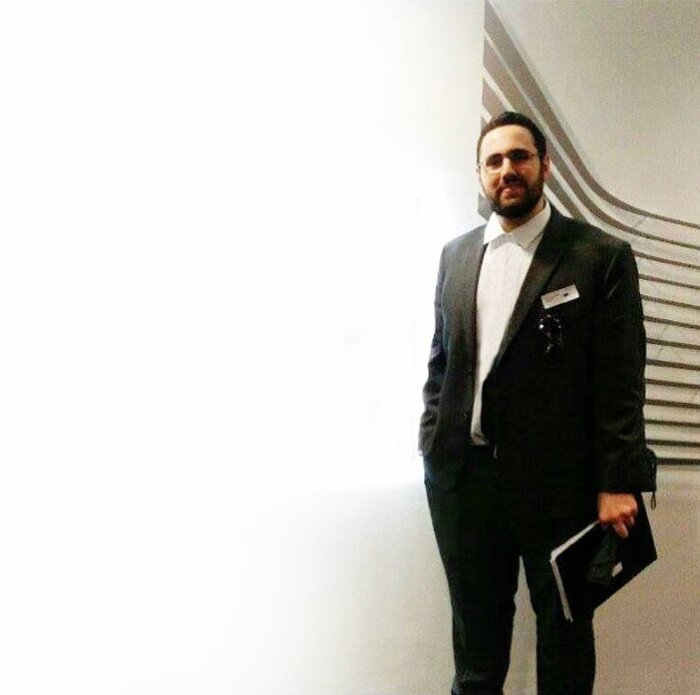
Q: Is it true that North Korea has helped Iran to build this hypersonic missile?
A: It is a common practice for the Western propaganda machine to attempt to downplay the accomplishments of independent states. They employ various techniques to mock, ridicule, and belittle the achievements of other countries for their own domestic audience, and yet portray them as threatening and dangerous, with the aim of selling their own weapons to gullible regimes.
The design is different than what North Koreans have shown with their Hwasong-8 system. The North Korean system, like the Chinese DF-17, uses its wedge shape to generate better lift and maneuverability, which in turn increases drag and radar signature. But the Iranian design features a traditional conical design, similar to the Russian Kinzhal and American LRHW. In Fattah, additional lift and maneuverability are generated by its state-of-the-art second engine
Q: Iran has also recently unveiled the Khorramshahr-4 missile. Tell us about it and its features that make it distinct from other missiles in Iran’s arsenal.
A: Khorramshahr-4, nicknamed „Kheybar“ – not to be mistaken with the Kheybar Shekan missile — has a range of 2,000 km. Unlike Fattah, it uses liquid fuel. But like Fattah, it too is a 2-stage missile that also uses thrust vectoring technology so it will be able to perform evasive maneuvers in outer space and evade exo-atmospheric anti-missile systems.
Based on the test footage and confirmed by Iranian commanders, it is evident that Kheybar utilizes a completely new engine and hypergolic fuel. One of the primary advantages of liquid fuels, in general, is their lower cost compared to solid fuels. However, there is a drawback: it takes considerably more time to prepare a liquid fuel missile for launch, rendering the launch site vulnerable to enemy attacks and limiting the ability to respond quickly to enemy threats. Unlike solid-fueled missiles, most liquid-fueled missiles need to be fueled up on the launch pad and launched shortly after, as they cannot be pre-loaded and transported safely.
However, Iranian scientists have developed a new liquid propellant that not only generates more thrust but is also significantly safer. As a result, Kheybar missiles can be stored pre-loaded for up to three years using standard methods, and up to a maximum of 10 years. This capability provides Iran with a rapid response capability at even a lower cost than before.
Kheybar reaches a maximum speed of 16 Mach in the midcourse phase and re-enters the atmosphere at 8 Mach. Its Circular error probable at its maximum range is under 30 meters.
To reduce drag, the steering fins in the warhead have been completely replaced with an 8-thruster attitude control system. This modification has not only contributed to speed enhancement but has also helped reduce the radar signature.
Prior to atmospheric re-entry, the guidance system meticulously fine-tunes the trajectory by nullifying flight path errors and optimizing the angle of attack. To ensure exceptional stability and utmost precision during re-entry into the dense atmosphere, the attitude control system executes rotational stabilization. The guidance system is subsequently deactivated to neutralize the potential impact of enemy electronic warfare on the Khoramshahr-4’s flight control system.
The Iranian missile program initially aimed to achieve a range of 1400 km. Then, based on Imam Khamenei’s recommendation, the focus shifted towards enhancing the missiles‘ accuracy, to eliminate civilian casualties and gain a one shot one kill capability. Currently, the program has entered its third phase in my view, with Iranian engineers and scientists working to improve other crucial characteristics of the missiles. This includes making them easier to store and transport, faster throughout all phases of launch, stealthier, and more cost-effective for mass production, among other objectives.
Q: Iran is accused of selling loitering munitions, specifically the Shahed-136 drone, to Russia. Firstly, tell us what you know about this famous drone. Then, give us your opinion on the possibility of weapon trade between Iran and Russia. Additionally, Sky News has published an article claiming to expose a document regarding the Iran-Russia weapon trade. I would like to hear your thoughts on that as well.
A: The Shahed-136 is a loitering munition, and the Western media often uses negatively charged terms to categorize it, such as „suicide drone,“ „one-way drone,“ or „single-use drone.“
One of the key advantages of the Shahed-136 is its impressive long-range capability, especially considering its low price tag. With a top speed of 185 kilometers per hour and powered by a 4-cylinder MD 550 engine, it can reach a distance of 2,500 kilometers. In comparison, the American Tomahawk’s Block IV has a range of 1,600 kilometers, and the Russian Kalibr missile is estimated to have a range of 1,500 to 2,500 kilometers. Despite its small size, the Shahed-136 is equipped with a powerful 50-kilogram explosively formed penetrator (EFP) warhead, ensuring significant damage upon impact. Additionally, its affordability enables mass production and deployment in large numbers, allowing for overwhelming enemy air defenses. Even if a Shahed-136 is intercepted and shot down, it still poses a victory for its operator. This is because the enemy would have likely used a much costlier missile to intercept it, incurring substantial time and financial costs for replacing their missile. Thus, the enemy’s valuable resources are depleted, and the sky is secured for more valuable friendly assets. Apart from its inexpensiveness and long range, the Shahed-136 possesses stealth characteristics due to various factors. These include its compact size, extremely low flight pattern, absence of a large vertical stabilizer, low speed, use of modern radar-absorbing materials in its structure, low heat signature, and the low profile of its launch platform. These features have enabled it to successfully penetrate highly guarded airspaces with ease. The Shahed-136 utilizes jam-resistant satellite navigation for midcourse guidance and infrared homing to precisely target its objective.
As for the second part of your question, I don’t really follow the likes of Sky News, and I strongly suggest everyone do the same. However, I don’t believe there is anything to expose. Iranian officials openly stated that they have sold armament to Russia—prior to the onset of the Russia-Ukraine war—and are negotiating to also purchase weapon systems such as Su-35s fighter jets from Russia. Again, it is related to your question about whether North Korea has provided Iran with hypersonic technology.
The Western propaganda machine always seeks to belittle others by tying their success stories to other people. If Iranians make something, they claim—citing anonymous sources—that North Koreans were behind it. If North Koreans launch a missile they manage to spot Iranians at the launch site.
Take for instance Shahed-136; depending on the days of the week they manage to find Iranian, Chinese, American, Russian, German, and Canadian parts in them and more recently they managed to discover that British universities are actually helping Iran with drone technology! This is all part of the typical disinformation campaign by the West which has blocked and censored free world news outlets from independent countries such as Iran, Russia, and China. One day Russians are eating Ukrainian babies, the next day Zelensky, the president of Ukraine, manages to shoot down 500 Shahed-136s, and the day after Putin, the president of Russia, is terminally ill and Russia is on the verge of a bloody coup d’état.

